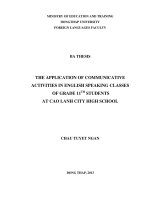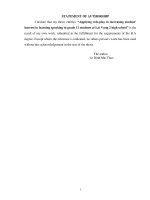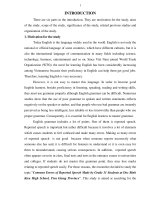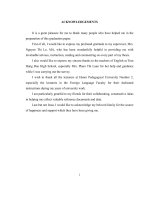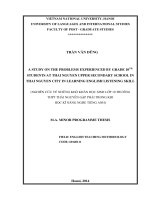ba thesis the application of communicative activities in english speaking classes of grade 11th students at cao lanh city high school
Bạn đang xem bản rút gọn của tài liệu. Xem và tải ngay bản đầy đủ của tài liệu tại đây (699.06 KB, 88 trang )
MINISTRY OF EDUCATION AND TRAINING
DONGTHAP UNIVERSITY
FOREIGN LANGUAGES FACULTY
BA THESIS
THE APPLICATION OF COMMUNICATIVE
ACTIVITIES IN ENGLISH SPEAKING CLASSES
OF GRADE 11
TH
STUDENTS
AT CAO LANH CITY HIGH SCHOOL
CHAU TUYET NGAN
DONG THAP, 2013
MINISTRY OF EDUCATION AND TRAINING
DONGTHAP UNIVERSITY
FOREIGN LANGUAGES FACULTY
BA THESIS
THE APPLICATION OF COMMUNICATIVE
ACTIVITIES IN ENGLISH SPEAKING CLASSES
OF GRADE 11
TH
STUDENTS
AT CAO LANH CITY HIGH SCHOOL
CHAU TUYET NGAN
Supervisor: TRAN THI HIEN M.A.
DONG THAP, 2013
i
DECLARATION
I confirm that the thesis entitled “The application of communicative activities in
English speaking classes of grade 11
th
students at Cao Lanh City High School” has
been performed and interpreted exclusively by myself. I clarify that the work is
submitted in partial fulfillment of the requirement of the BA degree and has not been
submitted elsewhere in any other form for the fulfillment of any degree or qualification.
The author
Chau Tuyet Ngan
ii
ACKNOWLEDGMENTS
I would foremost like to thank my supervisor, Tran Thi Hien M.A. for giving me
support, guideline and feedback when I carried out my study.
I would like to thank all of teachers in Foreign Languages Faculty at Dong Thap
University who provide me with necessary help as well as good suggestions whenever
I get into trouble.
I would also like to send my special thanks to all the grade 11
th
English teachers and
students at Cao Lanh City High School who help me carry out the research.
Last but not least, I would like to extend my gratefulness to my family, my friends and
many others who continuously offer spiritual support and encouragement during the
process of doing this study.
Chau Tuyet Ngan
iii
ABSTRACT
Communicative activities are essential in teaching and learning English because they
have the ability to draw students’ participation, help students improve their speaking
skill and train them for real-life situations. However, if they have been applied in real
teaching practice at high schools and if the application is in suitable methods? The
study was done for the purpose of finding out the reality of teaching and learning
English speaking with communicative activities of grade 11
th
at Cao Lanh City High
School. The data of research was collected by mean of questionnaires, also by the
researcher’s class observation and interviews. The results shown the communicative
activities were not applied in English speaking classes of 11 graders at the school so
lessons were designed and applied as the sample ones. Together with the result from
trial teaching, the benefits and challenges in the application of communicative
activities at the school were realized. Some solutions for the problem also were
suggested in the study.
iv
TABLE OF CONTENTS
DECLARATION…….……………………………………………………………i
ACKNOWLEDGEMENT…….……………………………………………………i
ABSTRACT…….…………………………………………………………………iii
TABLE OF CONTENTS……………………………………………………………iv
Chapter 1: INTRODUCTION.…… ……………………………………………1
1.1. Motivation…… ………………………………………………………………1
1.2. Aims of the study…… …………………………………………………………2
1.3. The research questions…… ……………………………………………………2
1.4. Scope of the study…………………………………………………………….2
1.5. The significance of the study…… ……………………………………………2
1.6. Previous related study………………………………………………………………3
1.7. Content of the study…… ……… ………………………………………………3
Chapter 2: LITERATURE REVIEW…… …………………………………4
2.1. English speaking skill…….……………………………………………………4
2.1.1. Definition of speaking skill…… ……………………………………………4
2.1.2. The importance of English speaking skill…… …………………………5
2.1.3. A speaking lesson…… ………………………………………………………6
2.1.3.1. Characteristics of a successful speaking lesson/ activity…….……6
2.1.3.2. Stages of a simple speaking activity………….……………………7
2.1.3.3. Shape of a speaking lesson…….………………….………………8
2.1.3.4. Some implications for teaching a speaking lesson………………10
2.2. Communicative activities……………… ……………………………………11
2.2.1. Definition of communicative activities………… …………………………11
2.2.2. Features of communicative activities………………… …………………12
2.2.3. The significance of communicative activities……… ……………………14
2.2.4. Ingredients for successful communicative activities……… ……………14
2.2.5. Sample communicative activities…………………… ……………………18
2.2.5.1. Information gap activities……… ………………………………18
v
2.2.5.2. Discussions………………… ……………………………………18
2.2.5.3. Role plays…………….….…………………………………………18
2.2.5.4. Class surveys………… …………………………………………19
2.2.6. The teacher’s role in communicative activities……… ……………………19
2.3. Techniques for teaching communicative activities…….…………………20
Chapter 3: METHODOLOGY………………………… ……………………22
3.1. Research questions……………….……………………………………………22
3.2. Setting and participants………….……………………………………………22
3.2.1. Research setting…………….………………………………………………22
3.2.2. Research participants.……….…………………………………………….22
3.2.2.1. The students……………….………………………………………22
3.2.2.2. The teachers………….….…………………………………………22
3.2.3. Data collection instruments….…….……………………………………23
3.2.3.1. Observation……………………….………………………………23
3.2.3.2. Questionnaires…….……….…………………………………….24
3.2.3.3. Interviews………… ………………………………………………26
3.2.4. Research procedure……….…………………………………………………27
Chapter 4: RESULTS AND DISCUSSION…… ……………………………28
4.1. Results……….………………………………………………………………28
4.1.1. Results from class observation……… ……………………………………28
4.1.2. Results from questionnaires…………….………………………………29
4.1.2.1. Questionnaires for the students………….………………………29
4.1.2.2. Questionnaires for teachers…………….…………………………38
4.1.3. Results from interviews …….……….………………………………….43
4.1.4. Results from trial teaching…………….……………………………………46
4.1.4.1. The researcher’ evaluation…….…………………………………46
4.1.4.2. The students’ opinions…………….………………………………46
4.1.4.3. Answering research questions…… ………………………………51
i. Question (1)…….………………………………………………………………51
ii. Question (2)…….……………………………………………………………53
vi
4.4. Discussion…….……………………………………………………………55
4.4.1. Reasons for difficulties…….………………………………………………55
4.4.2. Suggested solutions…… …………………………………………………56
Chapter 5: CONCLUSION…… ……………………………………………58
5.1. Summary, major findings and implications on teaching……… ……………58
5.1.1. Summary and major findings………….…………………………………58
5.1.2. Implications on teaching……….……………………………………………59
5.2. Limitations of the study and suggestions for further studies…………….…60
5.2.1. Limitations of the study………………….…………………………………60
5.2.2. Suggestions for further studies………… …………………………………60
REFERENCES
APPENDICES
1
Chapter 1
INTRODUCTION
1.1. Motivation
“Language learning helps to develop communication skills which are really vital if
you’re applying for a job or just in daily life, you need to be able to communicate.”
(Nuffield Languages Inquiry, 2000). This is also the purpose of those who are learning
English as a foreign language. The widespread of English leads to a surprising increase
of English learners nowadays, especially learners in Asian countries in general and
Vietnam in particular. Vietnamese students study English as a preparation for their
future jobs that usually require communication in English. In high schools, learning
English becomes more important for students since it is one of three compulsory
subjects in high-school finals. This also causes a common problem: The Grammar –
Translation method is mainly used. Teachers usually teach grammar rather than skills.
Teaching grammar is only to meet students’ demand at that time. After high-school
finals, students are not able to use English they have learnt for a long time for the
purpose of communication. They cannot speak English even in a daily conversation, so
how can they use English in a communicative environment in their jobs? The reality
requires that high school English teachers need to pay more attention to students’
listening and speaking skills. It is better for students if teachers apply Communicative
Language Teaching in classroom. To achieve the goals of learning English – to be able
to communicate with both native and non-native speakers – communicative activities
in English classes are very necessary. Particularly, it seems to be easy for teachers to
apply some communicative activities in speaking lessons which always deal with an
important characteristic – “learners talk a lot” (Brown, 2001). However, in reality,
some challenges prevent teachers from organizing the communicative activities in
speaking classes; a common one is limited teaching time.
2
Such problems mentioned above lead to the essential of the thesis: “The application of
communicative activities in speaking classes of grade 11
th
students at Cao Lanh City
High School”. The study is done for a particular group of students at a particular high
school in attempt to realize the real practice of speaking classes and provide solutions
for teachers to help their students learn English better.
1.2. Aims of the study
The research aims to:
Realize the reality of applying communicative activities in speaking classes of
grade 11
th
students at Cao Lanh City high school – benefits and challenges.
Find out some solutions for difficulties in teaching and learning process.
Suggest some implications for practicing communicative activities.
1.3. The research questions
1) What is the real practice of teaching and learning English in speaking classes of
grade 11
th
teachers and students at Cao Lanh City High School?
2) What are the benefits and challenges of applying communicative activities in
speaking lessons?
1.4. Scope of the study
The application of communicative activities will be studied. Particularly, the study
focuses on the benefits and challenges of the application for grade 11
th
students at Cao
Lanh City High School.
1.5. The significance of the study
The study makes certain benefits for teaching and learning English at Cao Lanh City
High School. It is to help the teachers realize the importance of communicative
activities in English speaking classes. By means of research instruments, the reality of
teaching and learning speaking in general and applying communicative activities in
particular are discovered. The benefits and challenges of the application of
communicative activities are focused on as well. Moreover, the study suggests some
3
solutions for the challenges, which are to help the teachers improve their speaking
lessons applying communicative activities. Therefore, it is a really helpful document
for teachers teaching grade 11
th
English at the school. They may pay more attention to
their teaching speaking skill lessons applying communicative activities. For students,
the study may also help them to realize the significance of learning speaking lessons,
which they do not before. It is to wake them up to see how their learning English
speaking is and how interesting and essential participating speaking activities in
classroom is. It gives them a chance to reconsider their learning at school as well. In
brief, the study brings advantages for both teachers and students.
1.6. Previous related study
The thesis about the application of communicative activities in English speaking
classes of grade 11
th
students at Cao Lanh City High School has not been done before
at Dong Thap University.
1.7. Content of the study
Chapter 1 is introduction, which presents an overview of the study in which the reason
for the research, the aims, the research methods, the scope as well as the content of the
study is briefly presented.
Chapter 2 is literatures review, which includes the theory of communicative activities
in teaching and learning English speaking skill.
Chapter 3 is methodology discussing some issues of research questions, research
participants and research procedure as well as data collection instruments.
Chapter 4 presents an overview result and discussion about the results of survey
questionnaires about communicative activities in Cao Lanh City High School grade
11
th
students’ classes.
Chapter 5 is conclusion of the study including summary, limitations of the study and
suggestions for further study are mentioned.
4
Chapter 2
LITERATURE REVIEW
2.1. English speaking skill
2.1.1. Definition of speaking skill
Among four skills of learning English, speaking merges as one of the most important
ones that are really essential to master for the purpose of language communication.
However, what is exactly speaking skill? “Speaking is the delivery of language through
the mouth”. Oxford dictionaries define “Speaking is the action of conveying
information or expressing one’s feelings in speech”. In addition, Speaking is "the
process of building and sharing meaning through the use of verbal and non-verbal
symbols, in a variety of contexts" (Chaney, 1998). Speaking is a crucial part of second
language learning and teaching.
In learning English, speaking skill is defined in different ways. “Speaking is a
productive skill in the oral mode. It is like the other skills, is more complicated than it
seems at the first and involves more than just pronouncing words.” (Azem, M. &
Dogar, M. H., 2011). Hornby (1995) defines that speaking is the skill that the students
will be judged upon most in real-life situations. It is an important part of everyday
interaction and most often the first impression of a person is based on his/her ability to
speak fluently and comprehensively. Additionally, “Speaking is one of the skills that
have to be mastered by students in learning English. Speaking is an essential tool for
communicating”. (Grognet A.G, 1997)
Speaking skill has many different aspects including two major categories – accuracy,
involving the correct use of vocabulary, grammar and pronunciation practiced through
controlled and guided activities; and, fluency considered to be “the ability to keep
going when speaking spontaneously” (Harmer, 2001). Bryne, D. (1986) additionally
declares that accuracy refers to the use of correct forms where utterances do not
contain errors affecting the phonological, syntactic and semantic or discourse features
5
of a language; fluency may be defined as the ability to get across communicative intent
without too much hesitation and too many pauses to cause barriers or a breakdown in
communication. In this case, instant correction may be inappropriate and could
interfere with the aims of the speaking activity.
2.1.2. The importance of English speaking skill
Speaking skill is really essential as it gives students the opportunity to practice real-life
conversations in the classroom. The teacher can use it as a tool to check how much
students have learned.
Speaking skill is very important in stages of language learning. (Azem, M. & Dogar,
M.H., 2011)
Stage 1: Pre-production. This is called the silent stage because speaking is still
limited; beginners listen and imitate rather than speak due to their difficulties in
vocabulary and grammatical structures. Listening comprehension activities should be
focused on instead of communicative ones because learners at this period will need
much repetition of English.
Stage 2: Early production. Learners are able to speak well in tasks thanks to
what they have been memorized although errors may occur. Speaking is begun.
Stage 3: Speech emergence. Learners can speak a lot with their enhanced
vocabulary. At this stage, short conversations between classmates are absolutely
possible. They can understand the information from others and respond as well as
make more questions to their partners in the manner of no attention to grammatical
structures.
Stage 4: Intermediate fluency. At the stage, discussions are improved. More
complex sentences are used in speaking to express their opinions and share their
thoughts. Learners are able to ask questions to clarify what they are not clear. Also,
there is an expanding of the talking topic.
6
Stage 5: Advanced fluency. Learners will be near-native speakers at this stage.
With their amount of vocabulary, they can react directly without any proper
preparation when speaking. Their facility in discussions has increased.
In learning speaking skill, a lot of learners regard speaking ability as the measure of
knowing a language and as the most important skill that they can acquire.
Speaking involves three areas of knowledge:
- Mechanics (pronunciation, grammar and vocabulary): Using the right words in
the right order with the correct pronunciation.
- Functions (transaction and interaction): Knowing when clarity of message is
essential and when precise understanding is not required.
- Social and cultural rules and norms (turn-taking, rate of speech, length of pauses
between speakers, relative roles of participants): Understanding how to take into
account who is speaking to whom, in what circumstances, about what, and for
what reasons.
The communicative language teaching (CLT) requires teachers to help students
develop speaking by providing authentic practice that prepares them for real-life
communication situations.
2.1.3. A speaking lesson
A speaking lesson is a kind of bridge for learners between the classroom and the world
outside. To build this bridge, the teacher needs to use some speaking activities to help
students apply the new language that they have learned. Then they can use language in
real situations outside the classroom.
2.1.3.1. Characteristics of a successful speaking lesson/ activity:
- Learners talk a lot: Learners should be speaking for most of the lesson/ activity.
This helps to achieve the goal of teaching English for communication.
7
- Participation is equal: All of the students should be grouped and organized so
that they can participate in the lesson/ activity not just a minority of talkative
students.
- Motivation is high: Learners are eager to speak because they are interested in
the topic and they want to contribute to the lesson/ activity.
- Language is appropriate: Learners’ discussion should be relevant, easily
comprehensible to each other, and at an acceptable level of language accuracy.
- Teacher monitoring and modeling: The teacher should be walking around and
monitoring conversations to ensure that the lesson is meeting its objectives and
that the level of the activity is appropriate.
2.1.3.2. Stages of a simple speaking activity
A simple speaking activity consists of three main stages: Setting up, Speaking practice
and Feedback.
- Setting up
The teacher introduces students the speaking topic. The specific steps are:
Explaining clearly: Breaking instructions into small steps.
Demonstrating: It is especially important in speaking activities, when students
are often working in pairs or groups that they know exactly what to do.
Double checking that everyone knows what to do.
Practicing the language with the whole class.
Practicing pronunciation.
Giving them support with speech bubbles
- Speaking practice
This is the main part of the activity. In this stage, students communicate with each
other in pairs or groups. The teacher usually follows these steps:
Giving clear signals when to start and stop
8
Circulating and listening: going around while students are speaking and
listening
Not interrupting but carrying a piece of paper and noting down mistakes and
problems
Controlling the activity: Making sure that it’s not too noisy and English is
spoken
- Feedback
Students may report to the rest of the class on what they have talked about in their pairs
or groups. The teacher gives feedback and deals with any problems. The teacher may
go through with the following steps:
Bringing the class back together
Asking a few students to report back
Giving feedback on the language practiced/ correcting mistakes
o The teacher writes mistakes taken during practice on the board
o Students try to correct them
o The teacher explains again if necessary
o The teacher focuses on pronunciation if necessary
2.1.3.3. Shape of a speaking lesson
Three main stages of a speaking lesson are: pre-speaking, while-speaking and post-
speaking. There is no exact time for each stage in a skills lesson in general and a
speaking lesson in particular; however, the teacher should notice that most of the time
must be for while stage, which gives students enough time for practicing speaking skill.
- Pre-speaking stage (Presentation stage):
The stage prepares students for getting them to think about the topic or situation before
they speak about it. Pre-speaking tasks can be: discussion or brainstorming, where
students collect all their ideas on the topic; vocabulary preparation, where the teacher
9
pre-teaches key vocabulary to aid comprehension; prediction, where students guess
what they may learn about. A good pre-speaking is also necessary to involve
integrating skills, maybe listening and sometimes reading (for example, an information
gap text). This stage should be kept short, about 10 minutes equivalent the
presentation stage of a Grammar lesson, but giving enough time for students to
assimilate to what they are going to speak. Warm-up activities may be included in this
stage.
In this stage, the teacher’s role is to get students think about what they are going to
speak before they speak. The teacher will have to set up the Pre-task and his/her clear
instructions are required.
- While-speaking stage (Practice stage):
This stage is the time for students to practice speaking. The teacher does not have to do
a lot of things because students will be working on the while tasks individually or in
pairs, in groups. When working on the tasks, they may have some difficulties because
of a lack of language variety; therefore, during this stage, the teacher may monitor and
assist weaker students with their difficulties in completing while tasks instead. Also,
the teacher needs to evaluate how well students have completed the tasks and whether
they are ready to go to the next stage or not.
Activities called communicative ones are truly essential to be applied in this stage for
the purpose of helping students practice speaking skill. They can be a role play, a game
or a discussion. Depending on the lesson and the classroom condition, the teacher will
choose and set up the suitable activities for students.
- Post-speaking stage (Personalization stage):
After students have practiced speaking skill in the while stage, they may do an
extension activity in this stage. This helps students take the information or whatever
they have produced in the previous stage and do something meaningful with it. The
post task is usually “an information transfer” – a production type of exercise where
they respond to what they have just learnt. They respond in the way that relating what
10
they have learnt to their own experience. For instance, if they talk about a world
famous football player in the while stage, they may talk or write about their own
favorite one in this follow-up stage. Writing is a very appropriate integrating skill for
this stage. If students conduct a questionnaire on their friends in the while task, they
may write up the results in a short paragraph, for example.
2.1.3.4. Some implications for teaching a speaking lesson:
Ur (1991) declares that “motivation is very strongly related to achievement in language
learning”. Students’ motivation on learning obviously affects the success of learning
process. In fact, students, however, may tend to be nervous about trying to say things
with many errors, so they are afraid of participating speaking activities. Partly they
may fear to be foolish in front of the others and worry about getting things wrong; they
may want to avoid teacher’s comments or corrections. To enhance students’ motivation
to participate speaking activities, there are some clear implications for the teacher.
- Making an effort in creating a relaxing atmosphere in class in order that most
students are not afraid of speaking in front of the rest of the class. Also, doing as
many speaking activities as possible in pairs and groups so that students can
comfortably speak English without the rest of the class listening.
- Exposing students as much as possible to naturally pronounced speech, and also
integrating some pronunciation work into the lessons. The more natural speech
they hear, the more effective their learning speaking.
- Accustoming students to combining listening and speaking in real time and in
natural interaction. This is very important for them to be familiar with listening
and speaking in the manner of combination. Then, in other real situations
outside classroom, they can listen and speak not very difficultly.
In addition, in communicative output, the teacher may also teach students some
speaking strategies which they can use to help them expand their knowledge of the
language and also their confidence in using it.
11
- Using minimal responses:
Such stock of minimal responses as idiom phrases that the teacher provides can
help students easily use to indicate understanding, agreement, doubt and other
responses to what another speaker saying. This is useful for language learners who
are not confident in their speaking.
- Recognizing scripts:
Some communication situations such as greetings, apologies, compliments,
invitations influenced by social and cultural norms often follow a set of spoken
exchanges – a pattern or a script. The teacher can help students feel more confident
in communicating by making them aware of these scripts. Then they can predict -
what the conversation follows and be able to respond easily.
- Using language to talk about language:
Reticence can occur when students are shy to say anything when they do not
understand another speaker or when others have not understood them. To help them
overcome this uncommunicativeness, the teacher can provide them strategies and
phrases to use for clarification and comprehension check. When students can use
these clarification phrases in class, it means that an authentic practice has been done.
Students can speak a lot with their confidence.
2.2. Communicative activities
2.2.1. Definition of communicative activities
Communicative activities refers to the classroom activities that provide a genuine
information gap and make it possible for language learners to communicate with target
language in Communicative Language Teaching Approaches (Liao, 2000). In other
words, communicative activities are activities that give students both a desire to
communicate and a purpose which involve them in a varied use of language. They have
real purposes: to find information, to break down barriers, to talk about oneself, and to
learn about the culture. Even when a lesson is focused on developing reading or writing
skills, communicative activities should be integrated into the lesson.
12
Communicative activities are fluency-based activities (Tait, S., 2001). While such
activities may involve students to practice a particular grammatical form, they are
likely to do more than this. The key element is that the activity is based on a realistic
situation. This could be anything from an encounter in a department store, to a group of
friends discussing holiday plans, etc. Within this kind of context, students should be
required to negotiate for meaning. This is likely to require multiple turn taking.
2.2.2. Features of communicative activities
Savignon (2001) claims that “the problem at present is that some of the activities being
introduced as communicative activities are not communicative at all but structure drills
in disguise”. Thus many teachers may think that the activities they design and use in
class are communicative, but actually they are not. Therefore the features that make a
real communicative activity should be focused on.
Based on related views about communicative activities, Sun & Cheng (2000)
summarizes three common features as follows:
- Communicative activities are task-based. Task-based English teaching concentrates
on communicative tasks that learners need to engage in outside the classroom.
- Communicative activities are learner-centered. The emphasis of teaching activity is
on students’ initiation and interaction. Students are expected to participate in the
activities as real people and take responsibility for their learning.
- Communicative activities emphasize the use of authentic language input and the
teacher’s native or near native language competence in order to produce
communication in the classroom.
Activities that are truly communicative also have three features in common; they are
information gap, choice and feedback (Morrow, 1981).
- An information gap exists when one person in an exchange knows something
the other person does not. For instance, if two students both know today is Tuesday and
one asks the other “What is today?” and he/she answers “Tuesday”, their exchange is
not really communicative.
13
- Speakers’ choices in communication are very important. Speakers should have
a choice of what they will say and how they will say it. If the teacher’s activity is
tightly controlled so that students can only say something in one way; they have no
choice and the exchange; therefore, seems not to be communicative.
- True communication is purposeful. A speaker can thus evaluate whether or not
his/her purpose has been achieved based on the information he/she receives from
his/her listener. If the listener does not have an opportunity to provide the speaker with
such feedback, then the exchange is not really communicative.
From these features, it may be easier to distinguish between communicative activities
and non-communicative activities. In a communicative activity, students must have a
desire to communicate, and there must be some communicative purposes to their
communication. Their attention, of course, will be focused on the content of what they
are saying rather than the form. They will use a wide variety of language, and the
teacher will not intervene by telling students they have made mistakes in their English
or correcting their pronunciation, etc. The teacher would not expect the materials
which students were using would control their language. For non-communicative
activities, there will be no desire to communicate, nor will students have a
communicative purpose. Students are involved in repetition or substitution drills so that
they can be motivated by the need to attain accuracy, not by a desire to achieve a
communicative objective. In these activities, the emphasis will be on the form of the
language, not the content. As a result, the teacher will entervene to ensure accuracy,
and the materials used will often designed to concentrate on a particular item of
laguage. We can represent the distinguishing features between the two types of
activities in the following way:
Communicative activities Non-communicative activities
A communicative purpose
A desire to communicate
Content not form
Variety of language
No teacher intervention
No materials control
No communicative purpose
No desire to communicate
Form not content
One language item
Teacher intervention
Materials control
14
2.2.3. The significance of communicative activities in speaking lessons
Every speaking lesson should be based on communicative activities which fulfil two
important language learning needs. They encourage students to acquire language
knowledge and prepare them for real-life language uses. Achieving the outcome
requires the participants to interact, which means not only speak with a person but also
listen to what he or she is saying and react to it.
Communicative activities have a strong effect on student’s motivation in the lessons.
They help students have more chance to talk to lots of classmates without a fear of
making mistakes. In a communicative activity, instead of having students stand in front
of class and talk to others, the teacher sets up the activity that they can talk to some
other students but not the whole class and the teacher. That makes a better effect on
helping students avoid their fear of making mistakes. Then they seem to be more
confident to speak and eager to speak a lot.
In Communicative Language Teaching (CLT), it is suggested that language should be
taught through the use of target language and practice communication, especially
through communicative activities. They focus on not only the grammatical structure of
the language but also the language use in real-life situations.
2.2.4. Ingredients for successful communicative activities
Communicative activities truly make a great contribution on the success of a speaking
lesson; however, what goes in to make a communicative activity succeed? Tait, S.
(2001) states that the success of communicative pair and group work activities is
almost always determined by the work the teacher does before students begin the
activity. This includes both what is done by the teacher before the class starts and what
is done in class to set up the task.
- Before class:
When preparing for communicative activities, it is really helpful for the teacher to ask
himself/ herself some following questions:
15
What can I do to set the scene or create a context?
The teacher, firstly, should picture a realistic situation (involves the location and the
relationship between speakers) where the language forms he/she has been teaching
might be used.
What is the purpose of the task?
The teacher tries to think why students would be talking within the context he/she has
thought of, and what would their objectives be. Every task used needs to have its clear
purposes on applying the language students have learnt and helping them practice
speaking fluently, not just for creating comfortable atmosphere in the classroom.
How can I generate interest in the activity?
There is no doubt that activities go better when students are interested in them.
Depending on the activity, there are various ways the teacher can create students’
interest; for instance, providing personal examples, modelling the activity in an
enthusiastic way, and having students reflect on similar experiences they are familiar
with.
Will students require preparation time?
Most research these days suggest that students perform better if they have been given
preparation time. Therefore this is pretty logical when the teacher think about it.
Without preparation time, students are required to do two things at once: use their
English language resources effectively and be creative. Preparation time can help them
avoid the pressure that comes with having to be creative while using the language
instinctively.
What type of groupings will be appropriate?
The teacher pre-considers some questions: Would the activity work best with students
in pairs or groups? Should they be seated or stood? Should they be faced to each other?
What type of exchanges should students is expected to produce?
This may be the most necessary element of the planning process. Writing out a sample
16
dialogue maybe the most effective way to gain a sense of language students will need
to produce to complete the activity. Anticipating the expected exchanges for students
may help the teacher predict some pitfalls and plan to avoid them effectively.
- In class
Tait, S. (2001) states some stages that the teacher may find them helpful for the process
of preparing students for an activity:
Setting the scene and generating interest: This might be the time to introduce a
personal story related to the communicative activity. It is also important to make sure
students know where they will be talking, who they will be talking to, and why they
will be talking.
Modelling preparatory task: If the teacher has decided to allow planning time, it
might be worth demonstrating how this time is to be used. For example, the teacher
might begin creating a list of suggestions for a sick friend.
Student preparation time: The students write while the teacher monitors.
Modelling: T-S, S-T, S-S. This is perhaps the most essential element for successful
communicative activities. It can be used:
- To show target language in action and elicit relevant language.
- To clarify/illustrate the requirements or the objectives of the task.
- To add useful/necessary conversational strategies.
- To highlight the type of conversational framework needed.
- To identify possible problem areas.
- To gauge the students' readiness to begin the activity.
- To build students’ confidence.
Pairworking: Monitoring, interrupting only if students really get stuck when they are
working in pairs or groups. Monitoring in order to aid the flow of conversation when
necessary, identify any common errors or areas of breakdown, offer encouragement,
and recognize when best to change the pairings.
17
Dealing with problems: While the teacher does not want to interrupt students in the
middle of a conversation, error correction can still be done effectively. Write typical
problems that we have heard on the board. After conversations have been completed,
the teacher draws students’ attention to these problems then encourages them to offer
suggestions for solving the problems.
Pairworking: New pairings. By repeating the activity with a new partner, students can
attempt to incorporate the corrections and suggestions made during the previous stage.
Concluding: Having students report on their findings. They can either report to a new
student or to the teacher. This final stage tends to bring a sense of closure to the
activity.
It depends on the lesson and the communicative activity applied that the teacher may
use or not use all of the “ingredients”. It is worthy keeping in mind what the teacher
should do to achieve a successful communicative activity are:
Identifying a “realistic” communicative context or situation.
Identifying a clear objective or purpose.
Ensuring there is an “information gap” or “opinion gap”.
Generating students’ interest.
Allowing students preparation time if necessary.
Being aware of the likely conversational framework or format.
Being aware of any useful/relevant conversational gambits.
Modelling.
Determining appropriate types of groupings.
Monitoring.
Involving students in the self-correction of errors.
Providing a sense of conclusion.

